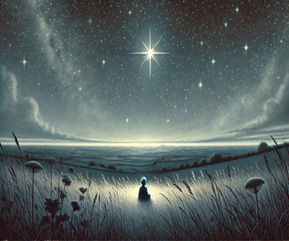 Twinkle, twinkle, little star,
Twinkle, twinkle, little star,
How I wonder what you are!
Up above the world so high,
Like a diamond in the sky.
Twinkle, twinkle little star,
How I wonder what you are?
This beloved rhyme, simple and familiar, carries a profound reminder that even in the vast darkness, tiny points of light can guide and inspire us. The little star is a symbol of hope and resilience, shining steadily even when surrounded by the unknown. It reminds us that no matter how overwhelming life may feel, small moments of light can sustain us, offering direction and comfort.
The star’s twinkle—small but persistent—shows that light doesn’t have to be overwhelming to be meaningful. Its wonder lies in its quiet presence, a beacon of hope and connection when all else feels distant. Like diamonds in the sky, these moments of light hold immense value, sparkling even in the deepest dark.
What does it mean to hold onto such moments? In the journey of tending to our needs and nurturing those around us, finding those tiny sparks—of joy, connection, or possibility—can transform the night into something navigable, even beautiful. This rhyme gently reminds us that no matter how long the night, the stars are always there, waiting to guide us, shining with quiet brilliance to help light our way.
The rest of the story:
Twinkle, twinkle, steadfast star,
Show us strength for who we are.
Through the dark, your light does stay,
Guiding my heart along the way.
Origins and History
The poem Twinkle, Twinkle, Little Star originates from an English lullaby called The Star, written by Jane Taylor and first published in 1806 in Rhymes for the Nursery, a collection by Jane and her sister Ann. Over time, this simple rhyme, set to a melody from a French folk tune (Ah! vous dirai-je, Maman), became a beloved nursery rhyme known worldwide.
The enduring appeal of Twinkle, Twinkle, Little Star lies in its universal theme of wonder and curiosity. The star in the night sky captures imaginations, symbolizing guidance, hope, and resilience—particularly meaningful to those facing darkness in their lives. For generations, this rhyme has offered comfort, connecting listeners to the vast sky above and to a sense of wonder within. Its simplicity makes it accessible, while its theme of light in the darkness resonates universally.
In various cultures, stars have been seen as symbols of hope, wisdom, or guardianship. Whether gazed at from an ancient village or a modern city, stars remind us of the constancy of light, even in our darkest moments.
